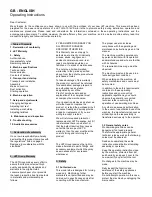
Model g0554z (Mfg 01/09+)
-57-
symptom
possible Cause
possible solution
Bad surface
finish.
1. incorrect spindle speed or feed rate.
2. dull tool or poor tool selection.
3. depth of cut too great.
4. too much play in gibs.
5. tool too high.
1. Adjust for proper spindle speed and feed rate.
2. use sharp tools; use correct tool for the operation.
3. reduce depth of cut and take more passes.
4. Adjust gibs (
page 58).
5. lower tool position.
Entire machine
vibrates
excessively upon
startup and while
running.
1. Workpiece is unbalanced.
2. Worn or broken gear present.
3. Chuck or faceplate has become unbalanced.
4. spindle bearings at fault.
1. reinstall workpiece so it is as centered with the
spindle bore as possible.
2. inspect gears and replace if necessary.
3. re-balance/replace chuck or faceplate; contact a
local machine shop for help.
4. tighten or replace spindle bearings (
page 62).
Cutting tool
or machine
components
vibrate
excessively
during cutting.
1. tool holder not tight enough.
2. Cutting tool sticks too far out of tool holder;
lack of support.
3. depth of cut too great.
4. gibs are out of adjustment.
5. dull cutting tool.
6. incorrect spindle speed or feed rate.
1. Check for debris, clean, and retighten.
2. reinstall cutting tool so no more than
1
⁄
3
of the total
length is sticking out of tool holder and it is secured
by at least two post bolts.
3. reduce depth of cut and take more passes.
4. Adjust gibs of affected component (
page 58).
5. replace or re-sharpen cutting tool.
6. use the recommended spindle speed or feed rate.
Can't remove
tapered tool from
tailstock quill.
1. Quill not retracted all the way back into the
tailstock.
2. debris not removed from taper before inserting
into quill.
1. turn the quill handwheel until it forces taper out of
quill.
2. Always make sure that taper surfaces are clean.
Cross slide,
compound rest,
or carriage
feed has sloppy
operation.
1. gibs are out of adjustment.
2. handwheel is loose.
3. lead screw mechanism worn or out of
adjustment.
1. Adjust gibs of affected component (
page 58).
2. tighten handwheel fasteners.
3. tighten any loose fasteners on lead screw
mechanism; adjust backlash (cross slide only,
page
58).
Cross slide,
compound rest,
or carriage feed
handwheel is
hard to move.
1. gibs are loaded up with shavings or grime.
2. gibs are too tight.
3. Backlash setting too tight (cross slide only).
4. Bedways are dry.
1. remove gibs, clean ways/dovetails, lubricate, and
re-adjust gibs (
page 58).
2. loosen gibs slightly, and lubricate bedways (
page
58).
3. slightly loosen backlash setting (
page 58).
4. lubricate bedways and carriage components (
page
51).
inaccurate
turning results
from one end of
the workpiece to
the other.
1. headstock and tailstock are not properly
aligned with each other.
2. Bedways are not level from side-to-side or
front-to-back.
1. realign the tailstock to the headstock spindle bore
center line (
page 33).
2. re-level the machine.
Chuck jaws won't
move or don't
move easily.
1. Chips lodged in the jaws.
1. remove jaws, clean and lubricate chuck threads,
and replace jaws.
Carriage won't
feed, or hard to
move.
1. Carriage lock lever tightened.
2. gears are not all engaged or broken.
3. gibs are too tight.
4. lead screw shear pin has sheared.
1. loosen the carriage lock lever.
2. Adjust gear positions or replace.
3. loosen gibs slightly (
page 58).
4. Correct the cause of shear pin breakage, and
replace shear pin (
page 60).
tailstock quill will
not feed out of
tailstock.
1. Quill lock lever is tightened.
1. loosen quill lock lever.
Operation and Work Results


































